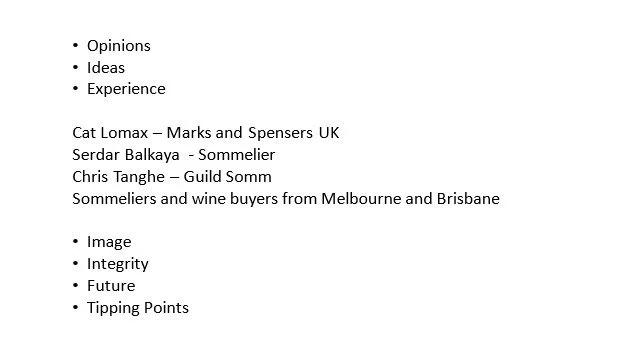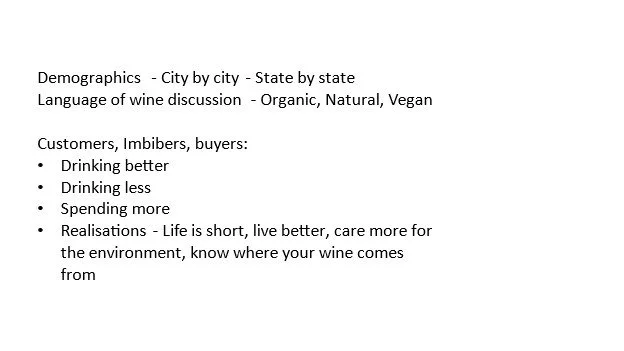Organic? Bio-dynamic? What are consumers drinking? - Organic Wine Growers Conference 2023
Organic & Biodynamic Winegrowing Conference
20 - 22 June
Across three incredible days a gathering of experts, researchers, growers, and many who care about how wine and the land can be better managed to grow even fine wines gathered to learn and discover what is going on in the world of Organic and Bio-dynamic wines. How do plants access better nutrients in the soil, how can the residues of land treatments, sprays and soil residues from fifty or eighty years ago affect and effect what can be achieved today? Can you have sheep in your vineyards more full-time, what benefits are there to having cows pee and poop in a vineyard?
All of these questions and ideas were explored.
I was speaker one, Day one - no pressure!
I was asked to talk about the perceptions that customers and wine buyers have about beverages today, wine especially, how Organic and Bio-dynamic wines are understood, who is drinking them and what the future for on-premise sales may look like. I could offer only a snapshot of what customers, Sommeliers and wine retailers are thinking and buying. I did speak to practioners in the industry from retail, to on-premise to education to get a three-dimentional look.
Below is my speech and the slide show presented.
There was sound played as well.
The sound file is loaded separately - excerpts taken from interviews.
Cameron
__________________________________________________________________________________________
The slides
The Speech
Kia Ora
The following is a snapshot of how Sommeliers are currently managing the business of beverages, our customers and guests and how we process the immense world of beverages
That static image represents the noise, confusion, and complexities of the beverage market, types of customers that sommeliers and wine retailers interact with, and the endless amount of information and data generated from online sources available 24 hours a day on the topic of wine.
Somehow, we navigate through.
The customer facing role is very rewarding especially for Somms, it is also very challenging, we must stay current, the world of beverages is constantly changing, new varieties, wine styles, tasting as much wine as possible to get a snapshot of region, vineyard, soil, vintage, brand ownerships changes, and more complex questions from customers as they too learn more.
On any given day through effective questioning in just over a minute or two, we have to find out exactly what our guests are really looking to drink. Is there some psychology involved - yes, some deductive reasoning - yes, making several recommendations, subtle education, and ultimately satisfaction for them when you get it right. Then you move onto the next table.
Wine and beverage drinkers have become a lot more certain about what they want to imbibe, how much, when, and are more discerning, knowledgeable, ready to select based on their research, have higher expectations of the product they choose and are not backwards in coming forwards about how they rate a wine, whether that’s based on your recommendation or review from a critic.
Today’s wine drinkers are spread across multiple demographic bubbles, a multiverse, reappearing in some, never in others and some in just one. For example – the value conscious, arguably older generation buyer who always purchases the $13.99 bottle from the local each week, expects the price to stay the same and taste exactly how they remembered from last week. Only when the price goes up by a dollar, or when the brand is no-longer available do they move from a single brand loyalty and price bubble to another. Then there’s the customer who comes in, examines the wine list and targets just one bottle of wine for the table, life is short, tonight’s wine will be expensive, it’s expensive wine, yet its chosen based on their research about the winemaker, viticulture and back story, our job becomes one of picking up on that thread of information to target attributes in the wine once open. Their information source varies and is changing as well - a podcast, magazine, chat with a wine specialist or through their circle of friends. Sommeliers are sometimes doing a little less selling just more specific wine buying, wine lists are arguably getting smaller, more specific to demographics and specifically aligned with food programs.
Speaking of demographics….
A group of Sommeliers I spoke with last week in Melbourne, suggested some of the continued success of organic, organge, pet-nat and natural wine love continues in specific parts of town over others because ‘that’s where many of the hospitality workers live and they like to drink beverages they don’t sell particularly well to customers in town. Others said they have small successful organic, natural and orange wine sections. It depends on location’.
I spoke with a different wine retailer in Melbourne who explained how they had proudly created a section in their store dedicated to Vegan and vegan-friendly wine, they told me the story of one customer who came through the door, read the sign and said ‘I don’t want any of that hippy garbage – show me something organic’.
This type of encounter somewhat demonstrates that the customer didn’t really know what the vegan sign meant yet did have some idea of what organic meant, or did they?.
That customer’s research flawed or not, into the meaning of vegan and organic had to come from somewhere in order for them to make a b-line for the section they thought was right for them. That information could have come from any number of sources including and most likely the internet, chat groups or engaging in lifestyle changes directing their wine selections.
Through these encounters and ideas, one thing is becoming clearer - knowledge uptake, discovery of wine styles and understanding of wine and how it is perceived - is evolving, creating new tipping points, allowing wine drinkers to move into other bubbles.
The image of wine and those who like to drink it appears to be changing as much as wine is, from developing varieties to cope better with climate change to label language and how wine companies use social media and website information to market their wares. To check if my suspicions about the integrity, future and current ideas about wine are valid, I spoke with some industry colleagues:
Cat Lomax – has been in the wine buying side of the business since 2009, a buyer for Laithwaites, Waitrose, Majestic and then most recently Marks and Spencers in London, in fact she heads the whole team for wine buying at M&S.
The most recent change Cat has seen is from when the pandemic began – Play sound.
She also mentioned how low and no alcohol craft beers & spirits are leading ahead of zero or low alcohol wines.
· I asked her what are the Gen Zers doing now that is different from the older generation? – Play sound
· Are Gen Zers spending, what are they buying? – Play sound
· Cat also mentioned that the Zers are also very brand conscious – so what about their attitude towards Organics, Biodynamics and Sustainability? – Play Sound.
When it comes to Organics, Biodynamics and Sustainability Cat says that Baby boomers don’t care, yet they are the ones currently keeping supermarkets and high-volume producers afloat. Millennials and Gen Z ers do care because it’s about lifestyle choices.
Millennials and Zers have not fallen into the same pattern as Boomers - so there’s a warning in there for supermarkets and high volume producers.
Sirdar Balkaya – Is a wine buyer and restaurant manager for a Michalin Start restaurant in London called Trivette, previously he was with a Heston Blumenthal dining space.
I asked Sirdar what he has noticed that has changed in the market from his perspective – after commenting on Covid he then explained how Brexit had disrupted the access to many classic European wines and using Burgundy and Bordeaux as examples he commented on the price now being ridiculous. For his dining situation what does that mean? – Play sound
· He also went on to suggest that people are cutting their budget for wine in order to still go out to a restaurant for a meal.
· We also talked about the impact on his wine program with the addition of Organic and Bio-dynamic wine – he said these terms are “wedged into the industry as marketing terms” compared to what his grandfather and that generation once took as normal. He also said: “my grandfather could name every plant on the property and its relationship to the vine”.
Sirdar did suggest the importance of wines with Organic and Bio-dynamic stories on his winelist are necessary – Play Sound.
· What was most telling was the clientele Serdar encountered that are in the 20-35 age group. They seemed to be more open minded about trying different wines he noted their demographic being mostly from eastern London when it came to organic, bio-dynamic and natural wine discussions – Play Sound
Chris Tanghe – is the Director of education at Guildsomm an online resource for beverage professionals and afficionados. Previously with Vinum import and distribution.
Chris and I spoke about the trade and tipping points for example where wine companies are challenged to continue the family legacy suggesting the next generation in some families are not there to take over the business. He did go on to say that some next generation are circling back to the [wine] business after exploring other interests first.
· He mentioned other tipping points with Gen Zers, and Millennials through what beverages they want to drink. Play sound
· Chris and I spoke about the rise in popularity of RTDs from cocktails in a can to the proliferation of gin producers and what impacts this was having on wine consumption: Play sound
· We also talked about the impacts and use of the terms Organic and Bio-dynamic and how they are currently perceived alongside environmental impacts: Play Sound
Our discussions on environmental impacts does still play a role in some wine buying decisions – a Think Global Act Local philosophy does still exist within some wine buyer behavior.
Sommeliers resident in Melbourne and Brisbane
In speaking with Sommeliers from two states in Australia I learned very quickly how diverse the industry is in terms of who is drinking what, when and where.
At retail for example, Pet Nat is a growing category, one retailer commenting “A buyer comes in the door, asks where the Pet Nat section is and all I have to do is point them in the right direction and they’re all good, they have done their research – they just needed to get the price match in place”
At on premise one Sommelier commented about specifically Organic, Pet Nat that they might be able to fit a couple in on the wine list”
Another Sommelier said, we have it, but I don’t like selling it, too risky.
Sommeliers are also seeing other changes in the sparkling wine category - the price of a glass of Champagne is becoming increasingly unreachable for some, the next choice for them is Prosecco over Methode Traditionnelle and for Methode itself – Tasmania before NZ.
There are a lot more knowledge-based purchases taking place as well – customers in restaurants and at retail tell us what they do want by experiential learning of what they don’t want; whether that’s what their parents introduced them to or the aforementioned vegan example whether that is fully understood or not.
One Sommelier commented that it’s easier to just sell wine on variety or style first and if the conversation extends to other information needs such as the incidence of organic farming in the growing or making of the wine then this can be revealed and woven into the conversation. There can be a sale lost if there is overselling or too much information offered, even if a wine is organic.
In Brisbane at both on and off-premise there was an increase in the need for more technical information by staff, especially with wines labelled Organic – that is to connect the specific farming to the winery techniques to the labelling, closure and reputation. This includes fermentation approach, whole bunch or not and time in oak, and not necessarily detailed on the back label, why cork versus screwcap, all preferably with a more direct conversation with the retailer or Sommelier.
One Sommelier commented “our discussions with customers are becoming more centered on texture in wine, and this is best showcased table side and not on the back label of the bottle”.
Another Sommelier who works in Queensland commented “ The region seems to be a blank canvas for drinkers, they are open to trying all sorts of different wines and styles”.
This highlights to a degree the morphing of some terminology that you and I might be very used to - yet there still seems to be a lot of education needed – whether that’s for the baby boomers or new comers to drinking wine – the modern meaning of label terms, for example: ‘organic’, once just material you might dig into your garden has largely morphed into a definitive and meaningful term on a wine label. This leads to different conversations with wine buyers especially Millennials and Gen-Zers.
The term ‘bio-dynamic’ has begun to morph too - from farming philosophy into meaningful everyday language for the wine buyer increasingly wants to discuss.
Our customers still have a lot of questions about these terms, so we need to be sure we keep weaving them into our conversations about wine.
So, what about the future:
Well, I refer you back to the slide showing the static noise of the industry, it is hard to navigate through, there is no easy pathway, each state, town, suburb and dining or retail space is different and can attract a different set of customers, in bubbles or not. It is hard to know what might be on the horizon as the world grapples with the next set of tipping points in the industry. From buyer behavior to the next generation of well-informed beverage buyers, again - not just wine; Sustainability, Climate and how Organic or terms related to Organic have meaning.
Change isn’t just coming - it’s here, now, Millennials, Gen-Zers and soon enough the Gen A-ers begin to dictate more of what they are looking for in a beverage.
The classic wines, well they are safe for now yet we need to keep asking the question – Who is going to be drinking wine, what variety and style in 2, 5 or 10 short years from now.
Nga Mihi
Live Long and Propser
Thank You
The sound file - interview excerpts - was played throughout the presentation - listen below





